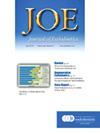硅酸钙水泥基封闭剂充填侧根管的疗效:一项模拟侧根管研究。
IF 3.6
2区 医学
Q1 DENTISTRY, ORAL SURGERY & MEDICINE
引用次数: 0
摘要
目的:通过微计算机断层扫描(μCT)分析硅酸钙水泥基或环氧树脂基封堵剂在不同充填技术下对模拟侧根管的充填能力。方法:用Reciproc R50锉对40只人下颌骨进行内固定,并在每个根三分之一(颈、中、尖)上建立两条侧根管。进行初始μCT扫描以确定外侧管的基线体积。然后根据封口器类型和插入技术将标本随机分为四组(n = 10): AH- gpc (AH Plus Jet®使用杜胶锥插入),BC-GPC (Bio-C®封口器使用杜胶锥插入),AH- at (AH Plus Jet®使用涂抹器尖端插入)和BC-AT (Bio-C®封口器使用涂抹器尖端插入)。所有标本均采用R50锥单锥技术进行封闭。封闭后,进行第二次μCT扫描,定性和定量分析侧根管填充情况,以百分比表示,由初始和最终根管体积之差计算。资料采用三因素方差分析及Tukey事后检验(p < 0.05),定性评分采用卡方检验(p < 0.05)。结果:BC-GPC组和BC-AT组充填率最高,分别为90.5±5.56%和90.8±6.65%。两种插入方式的充填质量无显著差异(p < 0.05)。定性分析结果显示,各组侧根管填充率均超过50%,各组间或根三分之一组间差异无统计学意义(p < 0.05)。结论:与AH Plus Jet®相比,无论采用何种插入技术,Bio-C®Sealer均能实现更好的侧根管填充。插入方式的选择对整体充填质量无显著影响。本文章由计算机程序翻译,如有差异,请以英文原文为准。
Efficacy of Calcium Silicate Cement-based Sealer in Filling Lateral Root Canals: A Simulated Lateral Canal Study
Introduction
To evaluate the filling capacity of calcium silicate cement-based or epoxy resin-based sealers in simulated lateral canals using different insertion techniques, through micro-computed tomography (μCT) analysis.
Methods
Forty human mandibular canines were instrumented with Reciproc R50 files, and two lateral canals were created in each root third (cervical, middle, and apical). An initial μCT scan was performed to determine the baseline volume of the lateral canals. The specimens were then randomly assigned to four groups (n = 10) based on the sealer type and insertion technique: AH-GPC (AH Plus Jet with insertion using a gutta-percha cone), BC-GPC (Bio-C Sealer with insertion using a gutta-percha cone), AH-AT (AH Plus Jet with insertion using an applicator tip), and BC-AT (Bio-C Sealer with insertion using an applicator tip). All specimens were obturated using the single-cone technique with an R50 cone. Following obturation, a second μCT scan was conducted for qualitative and quantitative analysis of the lateral canal filling, expressed as percentages and calculated by the difference between initial and final canal volumes. Data were statistically analyzed using three-way ANOVA with Tukey's posthoc test (P < .05), and qualitative scores were compared using the chi-square test (P < .05).
Results
The BC-GPC and BC-AT groups demonstrated the highest filling percentages (90.5 ± 5.56% and 90.8 ± 6.65%, respectively). No significant differences were observed in the filling quality between the insertion techniques (P > .05). Qualitative analysis revealed that more than 50% of the lateral canals were filled across all groups, with no significant differences among groups or root thirds (P > .05).
Conclusions
Bio-C Sealer achieved superior lateral canal filling compared to AH Plus Jet, regardless of the insertion technique. The choice of insertion technique did not significantly influence the overall filling quality.
求助全文
通过发布文献求助,成功后即可免费获取论文全文。
去求助
来源期刊

Journal of endodontics
医学-牙科与口腔外科
CiteScore
8.80
自引率
9.50%
发文量
224
审稿时长
42 days
期刊介绍:
The Journal of Endodontics, the official journal of the American Association of Endodontists, publishes scientific articles, case reports and comparison studies evaluating materials and methods of pulp conservation and endodontic treatment. Endodontists and general dentists can learn about new concepts in root canal treatment and the latest advances in techniques and instrumentation in the one journal that helps them keep pace with rapid changes in this field.
 求助内容:
求助内容: 应助结果提醒方式:
应助结果提醒方式:


